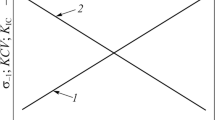Conclusions
-
1.
Low-cycle fracture of 09G2S steel with a test base of 2·104 cycles in the presence of an inhomogeneous stress pattern and a severe stress concentrator αc = 15 at normal temperatures (20°C) has a viscous character, with a pronounced zone of cyclic damage. The plastic characteristics of the material are high and the deformation (relative necking) always lies between 13 and 17%. There is no abrupt change in the fracture-inducing deformation over this cyclic range on moving from the region of quasistatic fracture to that of fatigue fracture.
-
2.
Preliminary cyclic loading leads to cumulative microscopic and macroscopic damage (development of deformation processes, fatigue damage, and cracking). There is a material increase in the tendency of the material toward brittle fracture and a decrease in its plasticity and fracture-stress level. The work of fracture is reduced by a factor of 2–10.
-
3.
Cyclic damage develops during the early stages of prestressing (at N=0.1 Nfrac) over a broad load range with a complex stress pattern.
-
3.a
A decrease in the cyclic stress (an increase in the number of cycles) leads to localization of the cyclic-damage processes. The tendency of the steel toward brittle fracture increases most rapidly under these conditions.
-
4.
Preliminary cyclic loading of structural steel with small test bases substantially (by a factor of 4–5) reduces low-temperature (−40°C) fracture characteristics before visible disruptions of material continuity occur. The initial stage of cyclic damage can thus lead to abrupt brittle fracture.
Similar content being viewed by others
Literature Cited
S. V. Serensen and N. A. Makhutov, “Investigation of deformation and fracture mechanisms of mild steel with a small number of cycles,” Zavod. Lab., No. 1 (1964).
A. D. Chudnovskii, “Influence of cyclic loading on the tendency of structural materials toward loss of plasticity,” Tr. TsNIITMASh, No. 73 (1967).
Yu. V. Kiselev and K. V. Popov, “Influence of cyclic deformation on the cold-shortness of steel during impact bending,” Izv. Vuzov, Mashinostr., No. 4 (1966).
I. A. Oding, A. G. Nikonov, and T. S. Mar'yanovskaya, “Influence of cyclic loading on the brittleness of carbon steel,” Dokl. Akad. Nauk SSSR,143, No. 6 (1962).
A. D. Chudnovskii, “Influence of low-cycle loading on the tendency of structural steel toward loss of plasticity,” Zavod. Lab., No. 12 (1967).
A. A. Glikman, “Change in the brittle strength of steel during cyclic plastic deformation,” Fizika Met. i Metalloved.,21, No. 4 (1966).
A. V. Shishkin, V. A. Vinokurov, and S. M. Isaev, “Influence of low-cycle loading on the resistance to brittle fracture of low-alloy steel in the presence of certain thermoplastic factors,” Izv. Vuzov, Mashinostr., No. 7 (1969).
V. A. Bykov, I. A. Razov, and L. F. Khudozhnikova, “Cyclic strength of ship-building steels,” Sudostroenie (1968).
A. D. Chudnovskii, “An apparatus for programmed repeated static loading,” Zavod. Lab., No. 10 (1964).
Additional information
Central Scientific-Research Institute of Technology and Machine Building. Translated from Problemy Prochnosti, No. 1, pp. 27–30, January, 1971.
Rights and permissions
About this article
Cite this article
Chudnovskii, A.D., Rafalovich, I.M. Influence of cyclic overloads on the strength characteristics of structural steel. Strength Mater 3, 24–27 (1971). https://doi.org/10.1007/BF01530367
Received:
Issue Date:
DOI: https://doi.org/10.1007/BF01530367




